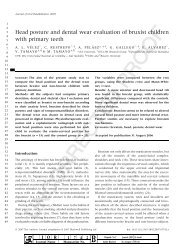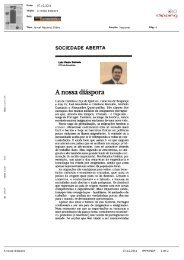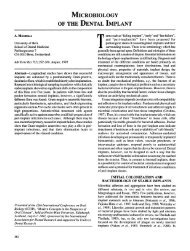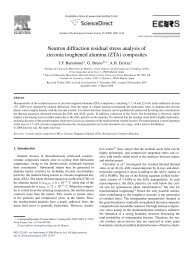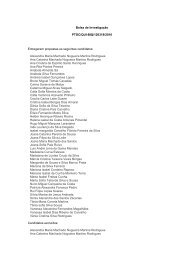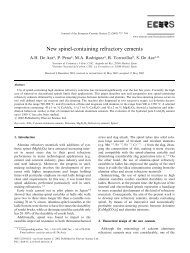Bioactive coatings deposited on titanium alloys - IBMC
Bioactive coatings deposited on titanium alloys - IBMC
Bioactive coatings deposited on titanium alloys - IBMC
Create successful ePaper yourself
Turn your PDF publications into a flip-book with our unique Google optimized e-Paper software.
Journal of N<strong>on</strong>-Crystalline Solids 352 (2006) 3488–3495<br />
www.elsevier.com/locate/jn<strong>on</strong>crysol<br />
<str<strong>on</strong>g>Bioactive</str<strong>on</strong>g> <str<strong>on</strong>g>coatings</str<strong>on</strong>g> <str<strong>on</strong>g>deposited</str<strong>on</strong>g> <strong>on</strong> <strong>titanium</strong> <strong>alloys</strong><br />
C. García a , S. Ceré b, *, A. Durán c<br />
a Universidad Naci<strong>on</strong>al de Colombia, sede Medellín, Colombia<br />
b INTEMA-Universidad Naci<strong>on</strong>al de Mar del Plata, Divisi<strong>on</strong> Corrosi<strong>on</strong>, Juan B Justo 4302, B7608FDQ Mar del Plata,<br />
Buenos Aires, Argentina<br />
c Instituto de Cerámica y Vidrio (CSIC), Madrid, Spain<br />
Available <strong>on</strong>line 4 August 2006<br />
Abstract<br />
One of the ways to minimise corrosi<strong>on</strong> products release from metallic implants to the surrounding tissue c<strong>on</strong>sists in applying a protective<br />
coating which may be functi<strong>on</strong>alised with a bioactive material, able to generate a natural b<strong>on</strong>ding to the living tissue. This work<br />
describes the development of a double layer coating obtained by the sol–gel technique c<strong>on</strong>taining bioactive glass, glass–ceramic or<br />
hydroxyapatite particles in hybrid methyl-triethoxisilane (MTES) and tetraethilorthosilicate (TEOS) sol <strong>on</strong> <strong>titanium</strong> alloy (ASTM F<br />
67). Samples were electrochemically evaluated in a simulated body fluid (SBF). The applicati<strong>on</strong> of the coating <strong>on</strong> the <strong>titanium</strong> alloy<br />
shows an improvement in the corrosi<strong>on</strong> resistance in the tested period of time. This improvement could be due to the reacti<strong>on</strong> of the<br />
particles with the physiological medium, which nucleates the formati<strong>on</strong> of calcium phosphate crystals, and blocks the porosity of the<br />
coating.<br />
Ó 2006 Elsevier B.V. All rights reserved.<br />
PACS: 81.20.Fw; 81.15.<br />
z; 81.65.Kn; 82.80.Fk<br />
Keywords: Biomaterials; Electrochemical properties; Films and <str<strong>on</strong>g>coatings</str<strong>on</strong>g><br />
1. Introducti<strong>on</strong><br />
The demand for metallic materials in medical and dental<br />
devices c<strong>on</strong>tinuously increases being very important in the<br />
medical field mainly due to their mechanical properties [1].<br />
However, the corrosi<strong>on</strong> of the metallic implants is critical<br />
because it could affect negatively the biocompatibility and<br />
the mechanical integrity. Large c<strong>on</strong>centrati<strong>on</strong>s of metallic<br />
cati<strong>on</strong>s coming from the prosthesis can result in biologically<br />
adverse reacti<strong>on</strong>s and might lead to the mechanical<br />
failure of the implant.<br />
Titanium and Ti-<strong>alloys</strong> are am<strong>on</strong>g the most used materials<br />
for in vivo applicati<strong>on</strong>s, due to their good physical and<br />
mechanical properties such as low density, high corrosi<strong>on</strong><br />
resistance and mechanical resistance. However, <strong>titanium</strong><br />
and other alloying metal i<strong>on</strong>s as aluminium and vanadium,<br />
* Corresp<strong>on</strong>ding author. Tel.: +54 223 4816600; fax: +54 223 4810046.<br />
E-mail address: smcere@fi.mdp.edu.ar (S. Ceré).<br />
release from the implants being accumulated in the nearby<br />
tissues, due to the aggressive acti<strong>on</strong> of the biological fluids<br />
[2–5]. The <strong>titanium</strong> itself is not toxic and its presence in soft<br />
tissues seems not to present allergenic or adverse reacti<strong>on</strong>s<br />
in cellular cultures [3,6].<br />
The aim of this work was the developing of sol–gel <str<strong>on</strong>g>coatings</str<strong>on</strong>g><br />
c<strong>on</strong>taining different bioactive particles of glass, glass–<br />
ceramic or hydroxyapatite <str<strong>on</strong>g>deposited</str<strong>on</strong>g> <strong>on</strong> the Ti6Al4V alloy.<br />
The film should reduce the corrosi<strong>on</strong> of the metal alloy<br />
which inhibits the metallic i<strong>on</strong>s release to the living tissue<br />
as well as promote bioactivity.<br />
2. Experimental procedure<br />
2.1. <str<strong>on</strong>g>Bioactive</str<strong>on</strong>g> particles<br />
<str<strong>on</strong>g>Bioactive</str<strong>on</strong>g> glass particles in the CaO–SiO 2 –P 2 O 5 system<br />
were obtained by melting at 1600 °C, using silica sand, calcium<br />
carb<strong>on</strong>ate (Aldrich) and orthophosphoric acid<br />
0022-3093/$ - see fr<strong>on</strong>t matter Ó 2006 Elsevier B.V. All rights reserved.<br />
doi:10.1016/j.jn<strong>on</strong>crysol.2006.02.110
C. García et al. / Journal of N<strong>on</strong>-Crystalline Solids 352 (2006) 3488–3495 3489<br />
(Aldrich) [7]. Glass–ceramic particles were obtained from<br />
the above menti<strong>on</strong>ed glass followed by a thermal treatment<br />
at 1050 °C for two hours, with the aim of obtaining<br />
hydroxyapatite and wollast<strong>on</strong>ite as crystalline phases.<br />
The hydroxyapatite particles were precipitated by the reacti<strong>on</strong><br />
of amm<strong>on</strong>ium phosphate and calcium nitrate at pH10<br />
[8]. All the particles were milled in an agate planetary mill<br />
(Frizsth Pulverisette, Germany), using a speed of rotati<strong>on</strong><br />
of 1500 rpm for 4 h. After milling, the particle size distributi<strong>on</strong><br />
was measured using a laser diffracti<strong>on</strong> equipment<br />
(Mastersizer S, Malvern, UK). The vitreous and the partially<br />
crystalline character of the materials were evaluated<br />
by means of X-rays diffracti<strong>on</strong>, using a Siemens difrac<br />
5000. Density of the powder materials was determined<br />
using a N2-adsorpti<strong>on</strong> BET (M<strong>on</strong>osorb, Quantachrome,<br />
USA).<br />
2.2. Sol–gel sol<br />
The sol was prepared by acid catalysis method in <strong>on</strong>e<br />
stage, using TEOS (Tetraethyl orthosilicate, ABCR), and<br />
MTES (Methyltrietoxysilane, ABCR) as silica precursors;<br />
absolute ethanol (Panreac) as solvent and 0.1 N nitric<br />
and acetic acid as catalysts. The water was incorporated<br />
from the nitric acid soluti<strong>on</strong> in stoichiometric ratio. The<br />
molar ratio of TEOS/MTES was 40:60. All the reagents<br />
were stirred at 40 °C during 3 h obtaining a transparent<br />
sol with a pH of 1–2, and a viscosity of 2.6 mPa [9].<br />
2.3. Suspensi<strong>on</strong>s<br />
The particle suspensi<strong>on</strong>s were prepared by the additi<strong>on</strong><br />
of 10% in weight of particles with respect to the soluti<strong>on</strong><br />
[9]. The suspensi<strong>on</strong>s were stirred by a high shear mixing<br />
in a rotor–stator agitator (Silvers<strong>on</strong> L2R, UK) during<br />
6 min. After the first 3 min, 0.5% by weight <strong>on</strong> solids of tetrapropyl<br />
amm<strong>on</strong>ium hydroxide (TPAH, Aldrich) was<br />
added as dispersant in the glass and glass–ceramic c<strong>on</strong>taining<br />
suspensi<strong>on</strong>s. The TPAH works as a cati<strong>on</strong>ic surfactant<br />
adsorbed <strong>on</strong> the surface of the glass and glass–ceramic particles,<br />
and raised the pH up to 6–7, becoming far from the<br />
isoelectric point of the particles. This, in turn, creates an<br />
electrostatic repulsi<strong>on</strong> between them that avoided the segregati<strong>on</strong>.<br />
In the hydroxyapatite suspensi<strong>on</strong> 2% by weight<br />
with respect to the solids of a phosphate ester was added<br />
as dispersant. The phosphate ester acts as an ani<strong>on</strong>ic surfactant<br />
adsorbed <strong>on</strong> the particles of the hydroxyapatite suspensi<strong>on</strong><br />
promoting the stabilisati<strong>on</strong> of the suspensi<strong>on</strong>.<br />
2.4. Coatings<br />
Mirror polished metal plates with a size of 7 · 3.5 ·<br />
0.2 cm of the <strong>titanium</strong> alloy Ti6Al4V (Goodfellow) were<br />
used as substrates. Samples were degreased, hand washed<br />
with distilled water, and rinsed in ethanol. Coatings were<br />
obtained by dip-coating at room temperature using a withdrawal<br />
rate of 28 cm min 1 . Double <str<strong>on</strong>g>coatings</str<strong>on</strong>g> c<strong>on</strong>sisting of<br />
a first coating of the SiO2 hybrid sol without particles, treated<br />
at 450 °C during 30 min, followed by a sec<strong>on</strong>d coating<br />
<str<strong>on</strong>g>deposited</str<strong>on</strong>g> <strong>on</strong> the top of the first <strong>on</strong>e, of the particle c<strong>on</strong>taining<br />
suspensi<strong>on</strong>s, followed by the same heat treatment were<br />
applied <strong>on</strong> the substrates. The <str<strong>on</strong>g>coatings</str<strong>on</strong>g> thickness was measured<br />
with a profilometer (Talystep, Taylor Hobs<strong>on</strong>, USA)<br />
<strong>on</strong> a scratch made <strong>on</strong> the film after the depositi<strong>on</strong>. The<br />
integrity and characteristics of the <str<strong>on</strong>g>coatings</str<strong>on</strong>g> were evaluated<br />
by optical microscopy (Olympus BX41, USA) and the<br />
images were analysed using appropriate software (Leyca,<br />
USA).<br />
2.5. Electrochemical assays<br />
Electrochemical experiments were performed using an<br />
electrochemical unit (Solartr<strong>on</strong> 1280B) in a Simulated<br />
Body Fluid (SBF) at pH7.3, after 1 and 10 days of immersi<strong>on</strong><br />
at 37 °C [10,11]. A traditi<strong>on</strong>al three-electrode cell was<br />
used. The coated sample was used as working electrode, a<br />
platinum wire as auxiliary electrode and a saturated calomel<br />
electrode (SCE, Radiometer) as the reference electrode.<br />
Impedance tests (EIS) were carried out at the corrosi<strong>on</strong><br />
potential (E corr ) with amplitude of 0.005 Vrms. Frequency<br />
was swept from 20000 to 0.01 Hz. Potentiodynamic polarizati<strong>on</strong><br />
curves were measured from the Ecorr to 1.4 V at a<br />
sweep rate of 0.002 Vs 1 . The modelling of the equivalent<br />
circuits was calculated by means of the Zplot software [12].<br />
2.6. In vitro bioactivity tests<br />
The capacity of the coated materials to induce apatite<br />
films <strong>on</strong> their surface was studied after immersi<strong>on</strong> in SBF<br />
during different periods of time. A total of 10 specimens<br />
of 3 · 2 cm of Ti6Al4V, coated with double <str<strong>on</strong>g>coatings</str<strong>on</strong>g> c<strong>on</strong>taining<br />
the different particles systems under study (glass,<br />
glass–ceramic and hydroxyapatite) were suspended independently<br />
in sealed polyethylene jars with 16 ml of SBF.<br />
The ratio of the exposed area of the sample to the fluid volume<br />
was of 0.3 cm 2 ml<br />
1 . Immersi<strong>on</strong> was maintained up to<br />
75 days, after that the samples were washed with distilled<br />
water and dried at room temperature. The analysis of the<br />
surface and the presence of the apatitic phases were carried<br />
out by means of Scanning Electr<strong>on</strong>ic Microscope (JEOL<br />
JSM5910LV).<br />
3. Results<br />
3.1. Particle characterizati<strong>on</strong><br />
The glass was colorless and transparent, and the glass–<br />
ceramic white and translucent [7,9]. The hydroxyapatite<br />
was white, opaque and presented good crystallinity [8].<br />
The crystalline phases present in the glass–ceramic were<br />
identified by X-ray analysis as wollast<strong>on</strong>ite and hydroxyapatite<br />
while the glass samples did not present any<br />
crystalline phase. Hydroxyapatite powders presented <strong>on</strong>ly<br />
hydroxyapatite as crystalline phase [8]. The average
3490 C. García et al. / Journal of N<strong>on</strong>-Crystalline Solids 352 (2006) 3488–3495<br />
Table 1<br />
Average particle size and density of the particles<br />
Particles Average particle size (lm) Density (g/cm 3 )<br />
Glass 10 ± 1 2.92 ± 0.05<br />
Glass–ceramic 11 ± 1 2.99 ± 0.05<br />
Hydroxyapatite 5 ± 1 3.11 ± 0.05<br />
particle size of the milled materials and their densities are<br />
shown in Table 1.<br />
3.2. Coating characterizati<strong>on</strong><br />
Fig. 1 shows the <str<strong>on</strong>g>coatings</str<strong>on</strong>g> obtained with the three types<br />
of particles as observed by optical microscopy. The <str<strong>on</strong>g>coatings</str<strong>on</strong>g><br />
present good integrity and homogeneous particle<br />
distributi<strong>on</strong>, without apparent defects. The glass and<br />
glass–ceramic particles occupy around 8% of the total area<br />
and the particle size varies of 10 ± 1 lm. The hydroxyapatite<br />
particles take up about 20% of the specimen area, and<br />
its particle size varies of 5 ± 1 lm.<br />
EIS diagrams for the Ti6Al4V alloy, bare and with the<br />
double coating c<strong>on</strong>taining glass, glass–ceramic and<br />
hydroxyapatite particles after 1 and 10 days of immersi<strong>on</strong><br />
in SBF, are presented in Fig. 2 as Bode plots. The three<br />
types of <str<strong>on</strong>g>coatings</str<strong>on</strong>g> show very similar behaviour after 1 day<br />
immersi<strong>on</strong> in SBF. The Bode diagrams (angle vs. frequency)<br />
show a capacitive behaviour in a wide range of frequencies,<br />
also showing a change of slope in the low<br />
frequency limit. The phase angle decreases gradually, but<br />
not reaching zero value; this might indicate the presence<br />
of pores in the coating and diffusi<strong>on</strong> phenomena between<br />
them [13]. However, it must be pointed, that after 1 day<br />
of immersi<strong>on</strong> in SBF the impedance module of the three<br />
types of <str<strong>on</strong>g>coatings</str<strong>on</strong>g> is higher than that of the bare metal for<br />
frequencies higher than 0.1 Hz.<br />
After 10 days of immersi<strong>on</strong> in SBF, all the coated samples<br />
present an impedance module about <strong>on</strong>e order of magnitude<br />
higher respecting to the bare metal and still higher<br />
than those of 1 day of immersi<strong>on</strong> in the whole range of frequencies<br />
under study. The curves corresp<strong>on</strong>ding to the<br />
three kind of samples present a capacitive behaviour in a<br />
wide range of frequencies. All of them present a single maximum<br />
value at the 80° phase angle. The maximum<br />
decreases progressively without getting zero value for the<br />
specimens coated with glass and hydroxyapatite c<strong>on</strong>taining<br />
<str<strong>on</strong>g>coatings</str<strong>on</strong>g>, and the angle is kept nearly c<strong>on</strong>stant at the low<br />
frequencies range for the glass–ceramic coated samples.<br />
In order to get better insights about the corrosi<strong>on</strong> feature<br />
occurring <strong>on</strong> the samples, EIS spectra were analyzed<br />
using equivalent electric circuits (Fig. 3).<br />
Fig. 4 shows the polarizati<strong>on</strong> curves corresp<strong>on</strong>ding to the<br />
double coated samples c<strong>on</strong>taining glass, glass–ceramic and<br />
hydroxyapatite particles, after 1 and 10 days immersi<strong>on</strong> in<br />
SBF. All the coated samples show passive behaviour in<br />
the whole range of potentials tested, and their passivati<strong>on</strong><br />
currents are 2–3 orders of magnitude lower than that of<br />
the uncoated samples. After 1 day of immersi<strong>on</strong> in SBF,<br />
the passivati<strong>on</strong> currents are 1.1 · 10 8 Acm 2 for the glass<br />
c<strong>on</strong>taining coating, 9 · 10 8 Acm 2 for the glass–ceramic<br />
c<strong>on</strong>taining coating and 4 · 10 8 Acm 2 for the hydroxyapatite<br />
c<strong>on</strong>taining coating. The passive behaviour is nearly<br />
c<strong>on</strong>stant after 10 days of SBF immersi<strong>on</strong>, with passivati<strong>on</strong><br />
currents, for 3 types of <str<strong>on</strong>g>coatings</str<strong>on</strong>g>, up to two orders of<br />
magnitude lower than the currents of the bare metal. The<br />
Fig. 1. Micrographs of the <str<strong>on</strong>g>coatings</str<strong>on</strong>g> c<strong>on</strong>taining the three types of particles. A: Glass, B: Glass–ceramic, C: Hydroxyapatite.
C. García et al. / Journal of N<strong>on</strong>-Crystalline Solids 352 (2006) 3488–3495 3491<br />
A<br />
-90<br />
-80<br />
Bare metal<br />
Glass ceramic 24 hours<br />
Glass ceramic 10 days<br />
Model<br />
10 6<br />
Bare Metal<br />
Glass ceramic 24 hours<br />
Glass ceramic 10 days<br />
Model<br />
Angle / grades<br />
-70<br />
-60<br />
-50<br />
-40<br />
-30<br />
-20<br />
| Z | / Ω.cm 2<br />
10 5<br />
10 4<br />
10 3<br />
10 2<br />
-10<br />
10 -3 10 -2 10 -1 10 0 10 1 10 2 10 3 10 4 10 5<br />
Frequency / Hz<br />
10 1<br />
10 -2 10 -1 10 0 10 1 10 2 10 3 10 4 10 5<br />
Frequency / Hz<br />
B<br />
-90<br />
-80<br />
Bare Metal<br />
Glass 24 hours<br />
Glass 10 days<br />
10 6<br />
Bare Metal<br />
Glass 24 hours<br />
Glass 10 days<br />
-70<br />
10 5<br />
Angle / Grades<br />
-60<br />
-50<br />
-40<br />
-30<br />
-20<br />
| Z | / Ω.cm 2<br />
10 4<br />
10 3<br />
10 2<br />
-10<br />
10 -2 10 -1 10 0 10 1 10 2 10 3 10 4 10 5<br />
Frequency / Hz<br />
10 1<br />
10 -2 10 -1 10 0 10 1 10 2 10 3 10 4 10 5<br />
Frequency / Hz<br />
C<br />
-90<br />
-80<br />
Bare Metal<br />
Hydroxyapatite 24 hours<br />
Hydroxyapatite 10 days<br />
Bare Metal<br />
Hydroxyapatite 24 hours<br />
Hydroxyapatite 10 days<br />
-70<br />
10 5<br />
Angle / Grades<br />
-60<br />
-50<br />
-40<br />
-30<br />
-20<br />
| Z | / Ω.cm 2<br />
10 4<br />
10 3<br />
10 2<br />
-10<br />
10 -3 10 -2 10 -1 10 0 10 1 10 2 10 3 10 4 10 5<br />
Frequency / Hz<br />
10 1<br />
10 -2 10 -1 10 0 10 1 10 2 10 3 10 4 10 5<br />
Frequency / Hz<br />
Fig. 2. Bode diagrams of the double <str<strong>on</strong>g>coatings</str<strong>on</strong>g> c<strong>on</strong>taining particles of A: Glass, B: Glass–ceramic, C: Hydroxyapatite, after 1 and 10 days of immersi<strong>on</strong> in<br />
SBF.<br />
passivati<strong>on</strong> currents after 10 days immersi<strong>on</strong> in SBF fluid<br />
is 1.1 · 10 7 Acm 2 for the glass c<strong>on</strong>taining coating,<br />
4 · 10 8 Acm 2 for the glass–ceramic c<strong>on</strong>taining coating,<br />
and 8 · 10 8 Acm 2 for the hydroxyapatite c<strong>on</strong>taining
3492 C. García et al. / Journal of N<strong>on</strong>-Crystalline Solids 352 (2006) 3488–3495<br />
Fig. 3. Equivalent electric circuit used for the modulati<strong>on</strong> of the Ti6Al4V<br />
system, coated with Glass, Glass–ceramic or Hydroxyapatite c<strong>on</strong>taining<br />
<str<strong>on</strong>g>coatings</str<strong>on</strong>g>, after 1 or 10 days immersi<strong>on</strong> in SBF.<br />
coating. It is worth noting that the glass–ceramic <str<strong>on</strong>g>coatings</str<strong>on</strong>g><br />
present an improvement after 10 days of immersi<strong>on</strong>, mean<br />
while hydroxyapatite and glass <str<strong>on</strong>g>coatings</str<strong>on</strong>g> showed a small<br />
deteriorati<strong>on</strong> after 10 days of immersi<strong>on</strong> in SBF.<br />
3.3. In vitro bioactivity test<br />
All the <str<strong>on</strong>g>coatings</str<strong>on</strong>g> c<strong>on</strong>taining either glass, glass–ceramic,<br />
or hydroxapatite particles formed an apatite film <strong>on</strong> the<br />
surface after some time of immersi<strong>on</strong> in simulated physiological<br />
fluid (SFB), this fact indicates that all <str<strong>on</strong>g>coatings</str<strong>on</strong>g><br />
tested are potentially bioactive [10,14,15]. The apatitic<br />
compositi<strong>on</strong> of the superficial film was c<strong>on</strong>firmed by<br />
DRX, FTIR and EDX (Fig. 5) [16]. As observed in Table<br />
2, the depositi<strong>on</strong> kinetics of the apatitic film <strong>on</strong> the <str<strong>on</strong>g>coatings</str<strong>on</strong>g><br />
depends <strong>on</strong> the kind of particles present in them.<br />
The first signals of apatite <strong>on</strong> the surface occurred after<br />
two days of immersi<strong>on</strong> and were detected by means of electr<strong>on</strong>ic<br />
microscopy and EDX. However, the kinetics of the<br />
formati<strong>on</strong> of this film is much lower in the case of the<br />
hydroxyapatite than in the glass and glass–ceramic particles<br />
and the total time required for the complete covering<br />
of the surface specimen is much l<strong>on</strong>ger with respect to<br />
the glass and glass–ceramic c<strong>on</strong>taining <str<strong>on</strong>g>coatings</str<strong>on</strong>g>, indicating<br />
a lower reactivity of the hydroxyapatite particles in c<strong>on</strong>tact<br />
with the simulated physiological fluid. Fig. 5 shows photographs<br />
of the deposits <strong>on</strong> the top of the Ti6Al4V samples<br />
that were coated with a layer c<strong>on</strong>taining glass particles,<br />
after 75 days of immersi<strong>on</strong> in SBF and the FTIR, EDX<br />
A<br />
1.6<br />
Bare Metal<br />
Glass 24 hours<br />
Glass 10 days<br />
B<br />
1.6<br />
Bare Metal<br />
Glass ceramic 24 hours<br />
Glass ceramic 10 days<br />
1.4<br />
1.4<br />
1.2<br />
1.2<br />
1.0<br />
1.0<br />
E / V<br />
0.8<br />
0.6<br />
0.4<br />
0.2<br />
0.0<br />
-0.2<br />
-0.4<br />
1E-9 1E-8 1E-7 1E-6 1E-5<br />
I / A/cm 2<br />
E / V<br />
0.8<br />
0.6<br />
0.4<br />
0.2<br />
0.0<br />
-0.2<br />
-0.4<br />
1E-8 1E-7 1E-6 1E-5<br />
I / A/cm 2<br />
C<br />
E / V<br />
Bare Metal<br />
1.6<br />
Hydroxyapatite 24 hours<br />
Hydroxyapatite 10 days<br />
1.4<br />
1.2<br />
1.0<br />
0.8<br />
0.6<br />
0.4<br />
0.2<br />
0.0<br />
-0.2<br />
-0.4<br />
1E-9 1E-8 1E-7 1E-6 1E-5<br />
I / A/cm 2<br />
Fig. 4. Potentiodynamic polarizati<strong>on</strong> curves of the Ti6Al4V alloy, bare and with double <str<strong>on</strong>g>coatings</str<strong>on</strong>g> c<strong>on</strong>taining A: Glass particles, B: Glass-ceramic particles,<br />
and C: Hydroxyapatite particles, after 1 and 10 days immersi<strong>on</strong> in SBF.
C. García et al. / Journal of N<strong>on</strong>-Crystalline Solids 352 (2006) 3488–3495 3493<br />
C<br />
A<br />
*<br />
**<br />
*<br />
B<br />
*<br />
**<br />
1400 1200 1000 800 600<br />
ν / cm -1<br />
15d<br />
7d<br />
3d<br />
0d<br />
400<br />
and DRX characterizati<strong>on</strong> of the deposits formed <strong>on</strong> the<br />
sample surface. The presence of Mg and Na in the EDX<br />
spectra can be attributed to the SBF where the samples<br />
were immersed.<br />
4. Discussi<strong>on</strong><br />
The procedure for preparing suspensi<strong>on</strong>s and coating<br />
depositi<strong>on</strong> was adequate for producing homogeneous <str<strong>on</strong>g>coatings</str<strong>on</strong>g><br />
and crack-free deposits with a regular distributi<strong>on</strong> of<br />
particles.<br />
Electrochemical tests show an interesting protective<br />
behaviour of the particle c<strong>on</strong>taining <str<strong>on</strong>g>coatings</str<strong>on</strong>g>. The evoluti<strong>on</strong><br />
in time of the double <str<strong>on</strong>g>coatings</str<strong>on</strong>g> presents an increase<br />
of the impedance module after 10 days of immersi<strong>on</strong> in<br />
SBF in the low frequency range. This behaviour could indicate<br />
that, although the <str<strong>on</strong>g>coatings</str<strong>on</strong>g> present pores and defects<br />
after 10 days of immersi<strong>on</strong> in SBF, these defects could be<br />
blocked by the corrosi<strong>on</strong> products of the metal or by the<br />
degradati<strong>on</strong> of the particles present in the coating.<br />
The electrochemical behaviour can be described in terms<br />
of an equivalent circuit in order to provide the most relevant<br />
parameters applicable to the corroding system. The<br />
equivalent circuit used for the adjustment of the experimental<br />
data is shown in Fig. 3. A c<strong>on</strong>stant phase element<br />
(CPE) was used instead of an ‘ideal’ capacitor, taking into<br />
account a certain degree of surface unhomogeneity, due to<br />
the deviati<strong>on</strong>s from 1 observed as capacities in the slope<br />
of the log/Z/ vs. logf curve. In the simulati<strong>on</strong> of the impedance<br />
plots, a finite Warburg impedance was included in<br />
order to account for the diffusi<strong>on</strong> of the electro active species<br />
through the pores or the defects of the coating. If the<br />
material is thin, low frequencies will penetrate the entire<br />
thickness, creating a finite length Warburg element (Eq.<br />
1) [12]<br />
Fig. 5. A: FTIR spectra of the double coated samples c<strong>on</strong>taining glass at<br />
various immersi<strong>on</strong> times. Y axis is shown in arbitrary units. Apatite bands<br />
are indicated with (*). B: EDX of the deposits after 75 days of immersi<strong>on</strong><br />
in SBF. C: Photomicrography of the deposits <strong>on</strong> the top of the Ti6Al4V<br />
samples that were coated with a layer c<strong>on</strong>taining glass particles after<br />
75 days of immersi<strong>on</strong> in SBF.<br />
Z w ¼<br />
R DO<br />
ðjT xÞ n tanhðjT xÞ n<br />
ð1Þ<br />
where R DO is associated with diffusi<strong>on</strong> in the solid phase<br />
and T is related to the diffusi<strong>on</strong> coefficient and the pore<br />
length. In the circuit, R X represents the electrolyte resistance,<br />
CPE c is related with the n<strong>on</strong> ideal capacitance of<br />
the oxide film, R po is the resistance presented by the porosity<br />
to the passage of the electrolyte. Parameters calculated<br />
by this type of modelling are shown in Table 3.<br />
The analysis of these data shows that, in all cases, the<br />
resistance associated to the pores (R po ) and the resistance<br />
associated to the diffusi<strong>on</strong> (R DO ) increase with the<br />
Table 2<br />
Bioactivity in vitro of the <str<strong>on</strong>g>coatings</str<strong>on</strong>g> c<strong>on</strong>taining glass, glass–ceramic, and hydroxyapatite particles<br />
Particle<br />
Average<br />
size (lm)<br />
% of the area occupied<br />
by the particles<br />
First signals of apatite <strong>on</strong> the<br />
surface of the coating (days)<br />
Glass 10 8 2 6<br />
Glass–ceramic 11 8 2 7<br />
Hydroxyapatite 5 20 2 14<br />
Test specimen totally<br />
covered with apatite (days)
3494 C. García et al. / Journal of N<strong>on</strong>-Crystalline Solids 352 (2006) 3488–3495<br />
Table 3<br />
Electrochemical parameters calculated based <strong>on</strong> the modelling of the electrochemical resp<strong>on</strong>se, for 24 h and 10 days immersi<strong>on</strong> periods (double <str<strong>on</strong>g>coatings</str<strong>on</strong>g><br />
with glass, glass–ceramic or hydroxyapatite particles)<br />
Particle Time of immersi<strong>on</strong> R X /Xcm 2 CPE c /X 1 s n cm 2 n R po /Xcm 2 R DO /Xcm 2 T/s 0.5 n<br />
Glass 24 h 12 4.39 · 10 7 0.87 7.37 · 10 4 2.08 · 10 6 53.52 0.98<br />
10 days 17 6.47 · 10 7 0.88 4.43 · 10 5 1.96 · 10 7 117.9 0.99<br />
Glass–ceramic 24 h 17 4.76 · 10 7 0.86 6.6 · 10 4 2.59 · 10 6 54.3 0.98<br />
10 days 15 2.93 · 10 7 0.85 2.82 · 10 6 1.24 · 10 7 98.8 1<br />
Hydroxyapatite 24 h 12 2.96 · 10 7 0.86 7.05 · 10 4 1.85 · 10 6 53.9 0.98<br />
10 days 15 3.18 · 10 7 0.84 2.44 · 10 5 1.31 · 10 7 117.7 0.99<br />
immersi<strong>on</strong> time. As the T parameter (directly proporti<strong>on</strong>al<br />
to the length of the pores and inversely proporti<strong>on</strong>al to the<br />
coefficient of diffusi<strong>on</strong>) increase with time, it could be<br />
assumed that the length of the pores increases due to the<br />
growth of a surface thin film or, that the area of the pores<br />
decreases with time. The capacity of the coating increases<br />
with time, which might indicate a decrease in the area of<br />
the defects. This area reducti<strong>on</strong> would be due to the pore<br />
and defect blocking caused by corrosi<strong>on</strong> products of the<br />
metal or by reacti<strong>on</strong> of the particles. Also, the reacti<strong>on</strong> of<br />
the particles with the SBF could form a thin film <strong>on</strong> the<br />
coating, increasing its thickness. Therefore, the area reducti<strong>on</strong><br />
and the increase of the thickness take the value of<br />
pseudocapacity of the coating to a nearly invariant point.<br />
The results of the EIS test for <strong>titanium</strong> alloy covered<br />
with a double coating c<strong>on</strong>taining any of the three different<br />
types of particles indicate that the reacti<strong>on</strong> of the particles<br />
with the medium could generate the formati<strong>on</strong> of a thin<br />
film <strong>on</strong> the electrode, and that this in turn could block<br />
the defects and the pores present in the coating. This blocking<br />
could cause a higher resistance to the diffusi<strong>on</strong> of the<br />
electro-active species to reach the metallic substrate (which<br />
causes corrosi<strong>on</strong> of the metal) increasing the apparent<br />
resistance of the system with time.<br />
However, the comparis<strong>on</strong> of these results with the polarizati<strong>on</strong><br />
curves (Fig. 4) show that for glass and hydroxyapatite<br />
<str<strong>on</strong>g>coatings</str<strong>on</strong>g>, the passivati<strong>on</strong> current density is slightly<br />
higher in all cases after the 10 days of immersi<strong>on</strong> in SBF<br />
than for the 24 h of immersi<strong>on</strong>, while the current density<br />
slightly decreases for the glass–ceramic c<strong>on</strong>taining coating<br />
after 10 days of immersi<strong>on</strong> when compared with 24 h of<br />
immersi<strong>on</strong>. This fact is in good agreement with that<br />
observed for the same kind of coating <strong>on</strong> stainless steel<br />
[7]. The beneficial effects of the glass-ceramic particles has<br />
also been evaluated in vivo <strong>on</strong> stainless steel and Cobalt<br />
<strong>alloys</strong> and this kind of particles showed the better bioactive<br />
resp<strong>on</strong>se [17,18]. C<strong>on</strong>versely, the formati<strong>on</strong> of the superficial<br />
thin film implies the reacti<strong>on</strong> of the particles with the<br />
medium, generating a bigger exposed area of the substrate.<br />
Although the material is covered by a thin film that<br />
decreases the access of the electrolyte to the pores and<br />
defects, the chemical nature of this film makes it to be<br />
<str<strong>on</strong>g>deposited</str<strong>on</strong>g> without a good adherence to the surface. The<br />
applicati<strong>on</strong> of an electrical potential could remove the film,<br />
leaving a bigger area of the substrate exposed to the medium<br />
and increasing the current density.<br />
As a general result, the applicati<strong>on</strong> of double coating <strong>on</strong><br />
the <strong>titanium</strong> alloy causes an improvement in the corrosi<strong>on</strong><br />
resistance during the time under study. This improvement<br />
can be due to the reacti<strong>on</strong> of the particles present in the<br />
coating with the physiological medium, which nucleates<br />
calcium phosphates <strong>on</strong> the surface and blocks the porosity<br />
of the coating generated.<br />
When the rate of formati<strong>on</strong> of apatitic phases film <strong>on</strong><br />
the different particles c<strong>on</strong>taining <str<strong>on</strong>g>coatings</str<strong>on</strong>g> surface is compared,<br />
it is possible to establish the reacti<strong>on</strong> kinetics of<br />
the three types of bioactive particles c<strong>on</strong>sidered in this<br />
work. Although all the particles showed to be bioactive,<br />
the hydroxyapatite is the less reactive, followed by glass–<br />
ceramic and glass. This behaviour is probably related to<br />
the particles size and the particle crystalline grade. It is well<br />
known that the crystalline grade affects the reacti<strong>on</strong> rate of<br />
the materials in the surrounding fluid [14,19]. The more<br />
crystalline the particles, the more retarded the reacti<strong>on</strong><br />
between the particles and the simulated body fluid to form<br />
apatitic phases and therefore their bioactivity is delayed.<br />
This explains the lower reactivity of glass–ceramic <str<strong>on</strong>g>coatings</str<strong>on</strong>g><br />
with respect to glass c<strong>on</strong>taining layers. On the other hand,<br />
the smaller reactivity of hydroxyapatite particles is evident<br />
in spite of their smaller particle size when compared with<br />
the glass and glass-ceramic particles, and the higher c<strong>on</strong>tent<br />
of particles in the <str<strong>on</strong>g>coatings</str<strong>on</strong>g>. Similar behaviour was<br />
observed in other studies evidencing the low reactivity of<br />
hydroxyapatite with simulated body fluid [7]. After these<br />
promising results for glass and glass–ceramic c<strong>on</strong>taining<br />
<str<strong>on</strong>g>coatings</str<strong>on</strong>g> in vivo test <strong>on</strong> Hokaido rats are in progress.<br />
5. C<strong>on</strong>clusi<strong>on</strong>s<br />
It is possible to obtain defect-free <str<strong>on</strong>g>coatings</str<strong>on</strong>g> <strong>on</strong> Ti6Al4V<br />
alloy, c<strong>on</strong>taining particles of glass, glass–ceramics and<br />
hydroxyapatite, using suspensi<strong>on</strong>s prepared with a soluti<strong>on</strong><br />
of TEOS/MTES c<strong>on</strong>taining either glass, glass ceramic or<br />
hydroxyapatite particles.<br />
All the <str<strong>on</strong>g>coatings</str<strong>on</strong>g> tested presented impedance modules<br />
higher than that of the bare metal, and also, indicating a<br />
protective role of the coating <strong>on</strong> the substrate. All the<br />
parameters calculated from the EIS experiments indicate<br />
that there is an improvement in the coating performance<br />
with the time of immersi<strong>on</strong> in SBF. These results would<br />
also indicate that, in spite of the <str<strong>on</strong>g>coatings</str<strong>on</strong>g> showing an<br />
important pore and defect density, these defects probably
C. García et al. / Journal of N<strong>on</strong>-Crystalline Solids 352 (2006) 3488–3495 3495<br />
could be blocked by the detritus of the metal or by the degradati<strong>on</strong><br />
products of the particles of the <str<strong>on</strong>g>coatings</str<strong>on</strong>g>.<br />
The reacti<strong>on</strong> of the particles with the electrolyte generates<br />
the deposit of a superficial film <strong>on</strong> the electrode that<br />
could block the pores and the defects. This blocking result<br />
in a higher diffusi<strong>on</strong> resistance for the electro active species<br />
to the metallic substrate and, therefore, it c<strong>on</strong>ducts to a<br />
decrease of the corrosi<strong>on</strong> when increasing the immersi<strong>on</strong><br />
time.<br />
The polarizati<strong>on</strong> curves showed that the double <str<strong>on</strong>g>coatings</str<strong>on</strong>g>,<br />
with the 3 types of particles, have a protective acti<strong>on</strong><br />
<strong>on</strong> the bare metal, both, after 1 and 10 days of immersi<strong>on</strong><br />
in SBF. After 10 days of immersi<strong>on</strong> in SBF, the glass ceramic<br />
double layer coating has better corrosi<strong>on</strong> resistance<br />
than after 24 h. This indicates that the dissoluti<strong>on</strong> products<br />
are blocking effectively the electrochemical process at the<br />
pores and the defects of the coating, acting as a protective<br />
layer against corrosi<strong>on</strong> and i<strong>on</strong> diffusi<strong>on</strong>.<br />
The applicati<strong>on</strong> of double coated sample c<strong>on</strong>taining<br />
particles <strong>on</strong> the <strong>titanium</strong> alloy showed an improvement<br />
<strong>on</strong> the corrosi<strong>on</strong> resistance in the tested period of time.<br />
This improvement could be due to the reacti<strong>on</strong> of the particles<br />
with the physiological medium, which nucleates the<br />
formati<strong>on</strong> of calcium phosphate crystals, and blocks the<br />
porosity of the coating (initial or post-formed).<br />
Acknowledgements<br />
The authors wish to thank to CYTED program for the<br />
partial financing through Network VIII.E and project<br />
VIII.9, as well as CICYT project MAT2003-05902, PICTO<br />
11338 (ANPCyT-UNMdP), DIME-Colciencias, Universidad<br />
Naci<strong>on</strong>al de Colombia and CSIC-CONICET Cooperati<strong>on</strong><br />
Project.<br />
References<br />
[1] S. Roessler et al., Colloid. Surface B (2002) 387.<br />
[2] A.W.E. Hodgs<strong>on</strong> et al., Electrochim. Acta (2002) 1913.<br />
[3] D. Zaffe, C. Bertoldi, U. C<strong>on</strong>solo, Biomaterials (2003) 1093.<br />
[4] T.M. Yue et al., Mater. Lett. (2002) 206.<br />
[5] B. Finet, G. Weber, R. Cloots, Mater. Lett. (2000) 159.<br />
[6] I. Milosev, M. Metikos-Hukovic, H.H. Strehblow, Biomaterials<br />
(2000) 2103.<br />
[7] C. García, S. Ceré, A. Durán, J. N<strong>on</strong>-Cryst. Solids (2004) 218.<br />
[8] C. García et al., Key Eng. Mater. (2005) 47.<br />
[9] C. García, A. Durán, R. Moreno, J. Sol–Gel Sci. Technol. (2005) 211.<br />
[10] C. Ohtsuki, T. Kokubo, T. Yamamuro, J. N<strong>on</strong>-Cryst. Solids (1992)<br />
84.<br />
[11] T. Kokubo, Acta Mater. (1998) 2519.<br />
[12] Z. Scribner, Plot for Windows, Electrochemical Impedance Software<br />
Operating Manual. Part I, I. Scribner Associates (Ed.), Southern<br />
Pines, NC, 1998.<br />
[13] C. Liu et al., Corr. Sci. (2003) 1257.<br />
[14] T. Kokubo et al. (Eds.), Chemical reacti<strong>on</strong> of bioactive glass and<br />
glass ceramics with a simulated body fluid. Journal of Materials<br />
science: Materials in medicine, vol. 3 (1992) 79.<br />
[15] T. Kasuga et al., J. Mater. Sci. (1987) 3721.<br />
[16] A. Durán et al., J. Mater. Chem. (2004) 2282.<br />
[17] C. García, Bioactivación de metales de uso ortopédico mediante<br />
recubrimientos producidos por sol–gel, Instituto de Cerámica y<br />
Vidrio, Universidad Autónoma de Madrid: Madrid, 2004, p. 263.<br />
[18] J. Ballarre et al., J. N<strong>on</strong>-Cryst. Solids (2002) 278.<br />
[19] T. Kokubo, A/W glass–ceramic: processing and properties, in: J.<br />
Wils<strong>on</strong> (Ed.), An Introducti<strong>on</strong> to Bioceramics, World scientific,<br />
Singapore, 1993, p. 75.


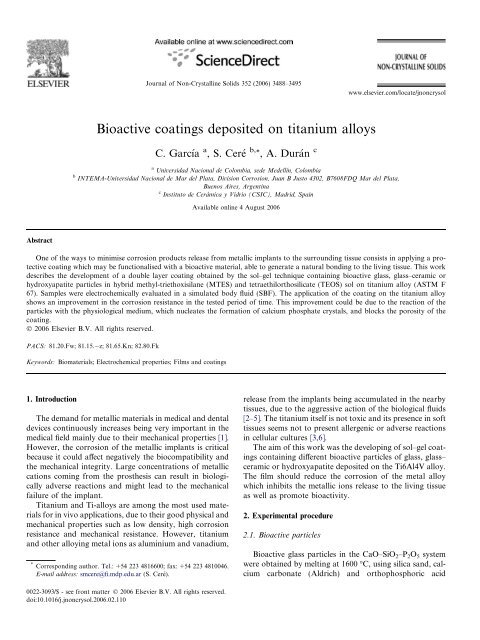

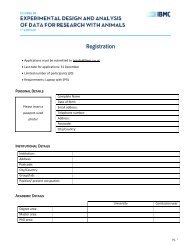

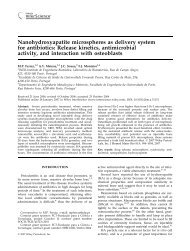
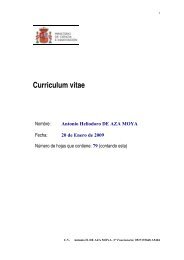
![registration form - download [pdf] - IBMC](https://img.yumpu.com/22442689/1/184x260/registration-form-download-pdf-ibmc.jpg?quality=85)
